Community Environment Health & Wellness News
Famed Willits Canoes get a Gig Harbor homecoming
Phil Miller already has checked the tide charts. He’s regularly checking the weather forecasts.
Why?
This weekend, Miller, a retired Gig Harbor firefighter usually busy with other pursuits, plans to lead an armada up Hale Passage to invade an island.
OK. So it’s only a little local island.
OK. So the landing craft are only 17 feet long.
OK. So the islanders plan to welcome them.
So. No big deal?
No. Big deal. Not only that, the public can get involved.
Willits canoes
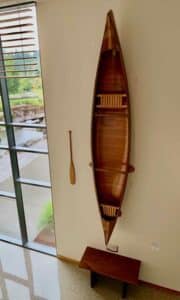
A Willits canoe hangs on the wall at St. Anthony Hospital in Gig Harbor. Photo by Chapin Day
“It may be the largest gathering of Willits canoes ever,” according to Pat Chapman, Olympia-based author of “The Willits Brothers and Their Canoes.”
Chapman’s book, published in 2006, remains the definitive history of two intriguing local men, brothers Earl and Floyd Willets. The pair, young immigrants from the Midwest to the Northwest, began building and experimenting with canoes as teenagers in Tacoma.
In 1914 on the Gig Harbor peninsula, they began their rise to prominence in the canoe-savvy world. With a trace of exaggeration but with sincere intent, some exuberant fans insist that the Willets brothers are to canoes what the Stradivari family is to violins.
During almost 50 years in business, without ever hiring a permanent employee, Earl and Floyd four-handedly and meticulously designed, built and marketed 918 canoes. For the first few decades, the base price was less than $100. Today, a top-condition vintage Willits can command $10,000, maybe more.
The uniquely built canoes are notable for their craftsmanship and the way they handle. However, some present-day owners may be more interested in art and decor than in paddling, Miller said. “They have them just to admire them.”
The Willits brothers
You can admire them too.
On Saturday morning, Aug. 26, the public is invited to a free owners’ showing of perhaps 30 Willits canoes, some more than 100 years old, at the Gig Harbor Vintage Aero Museum. The museum is located at the Tacoma Narrows Airport, 1108 26th Avenue NW, not far from the original home of Earl and Floyd’s canoe shop.
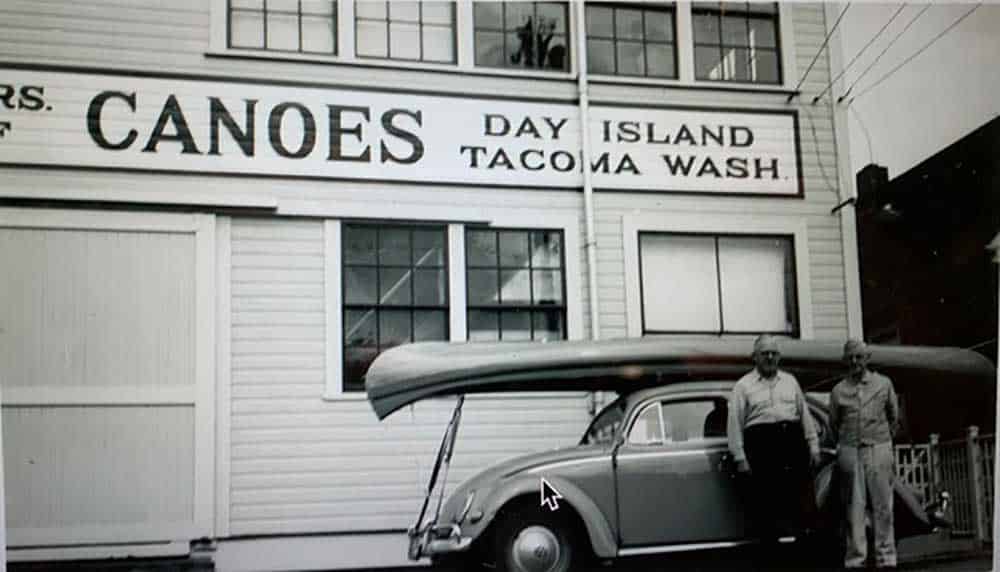
The Willits brothers outside their Day Island shop in 1960. Willits Collection, Tacoma Public Library
Although they eventually moved their enterprise to Day Island, from 1914 to 1921 they crafted their canoes in a small waterfront shed they built near the entrance to Wollochet Bay on East Bay Drive. They even christened their first canoes as Artondales, in recognition of the location.
The company history, detailed in Chapman’s book and on several internet sources, unfolded over the ensuing decades. It is replete with tales of the two somewhat secretive and seemingly mismatched brothers. Despite markedly differing personalities, each exhibited distinct skill sets, creative inventiveness and a near-obsessive perfectionist streak. Nevertheless, though disputed by some witnesses, reports persist that they did not get along.
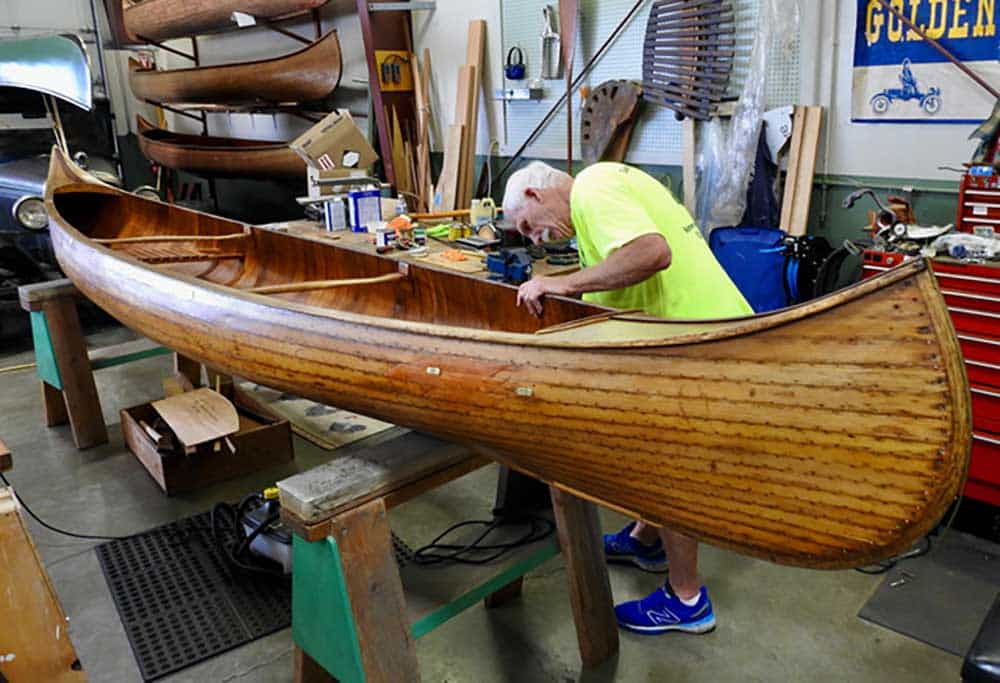
Phil Miller inspects one of the last of the Willits canoes built at the Wollochet shop. Photo by Chapin Day
“I wouldn’t say they hated each other,” Miller said, adding that they found it “beneficial to business” to adapt their production to their differences. “They worked better apart than side-by-side.”
Even the two-story boat shop they designed and built at the south end of Day Island reflected the split. The quieter, less-outgoing Earl worked on the ground floor creating parts, inventing tools and keeping detailed records. Upstairs, the somewhat more gregarious Floyd used Earl’s output to build each canoe piece by piece. Floyd also was more likely to be the face of customer service.
Popular with the paddling set
And there were customers aplenty. Buyers faced waiting lists of several years’ duration. Sticking to the basics of their graceful 17-foot design, the brothers made changes just five times over five decades, changes that can challenge the eye of uninitiated while sparking earnest conversation and dispute among aficionados.
Whatever tensions may have existed in the boat house were not discernible in each canoe, a varnished assemblage of carefully selected and milled wood parts, over 7,000 perfectly arrayed copper tacks, brass screws with head slots carefully aligned, not to mention the options available — seats, sailing rigs, paddles. All perfection.
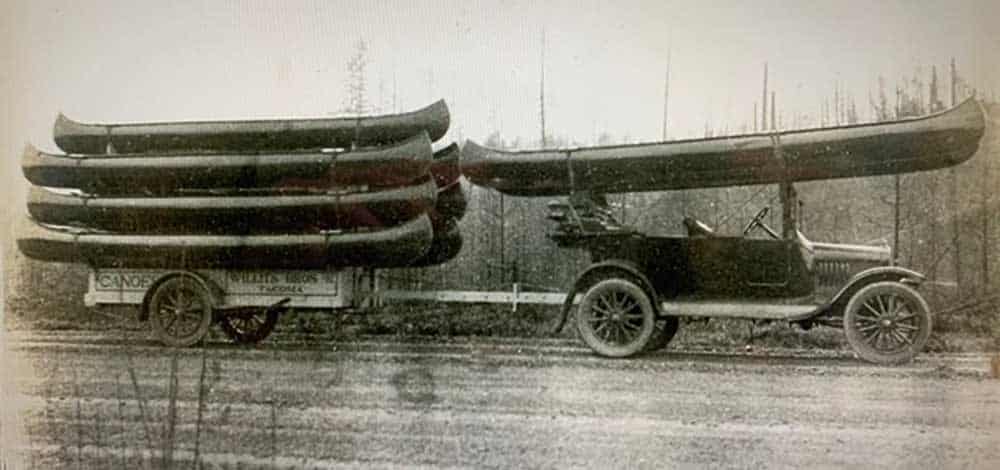
A trailer load of Willits canoes ready for delivery to a customer. Willits Collection, Tacoma Public Library
The final evidence of the interdependence of the brothers is an imperfect canoe, the last built. After his brother died in 1962, Earl tried his hand at taking on the upstairs work. He was so disappointed in the result, he would not sell it and is said to have wanted to burn it. No more canoes emerged from the shop. Earl died in 1967.
From then until just recently, the shop sat relatively undisturbed for more than 50 years. Now, remaining Willets family members have donated its contents to Tacoma’s Foss Waterway Seaport museum. The brothers’ extensive and detailed records, photos and papers are in the care of the Tacoma Public Library. The boat shop building, which has been modified over the years, recently sold.
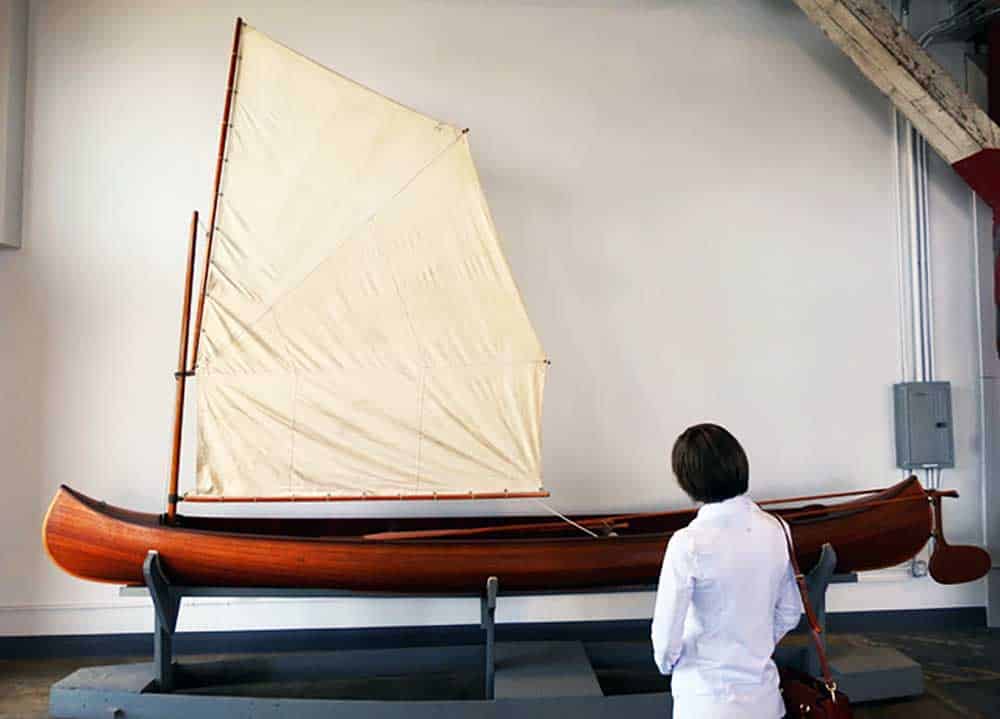
A Willits canoe equipped with a sail at the Foss Waterway Seaport museum in Tacoma. Photo by Chapin Day
Tanglewood Island
Among those expected to attend the Saturday morning event at the Gig Harbor Airport-based museum are author Chapman, organizer Miller, and many other devoted and enthusiastic, if not to say obsessed, Willits owners. At least one will have driven more than 2,000 miles to bring his canoe from Chicago to join in the festivities, Miller said.
Canoes will be on display throughout the morning beginning at 9:30 a.m.
On Saturday afternoon, owners who want to participate are to launch their canoes at the 10th Street boat ramp. The fleet will head out on a round-trip voyage to Tanglewood Island, a postage stamp of forested soil nestled alongside Fox Island.
Locals know Tanglewood by its distinctive, recently refurbished and decorative lighthouse, remnant of a prior owner’s dream. During the 1940s and 50s, that owner ran a boys’ camp on the island, a camp equipped with a fleet of — you guessed it — Willits canoes, some of which are still owned by island residents.
On Sunday, some owners plan to display their canoes at the Foss Waterway Seaport in Tacoma. That maritime museum already has several Willits canoes in its collection.
For more information about Saturday’s airport display, contact Miller at [email protected] or (253)651-4703.
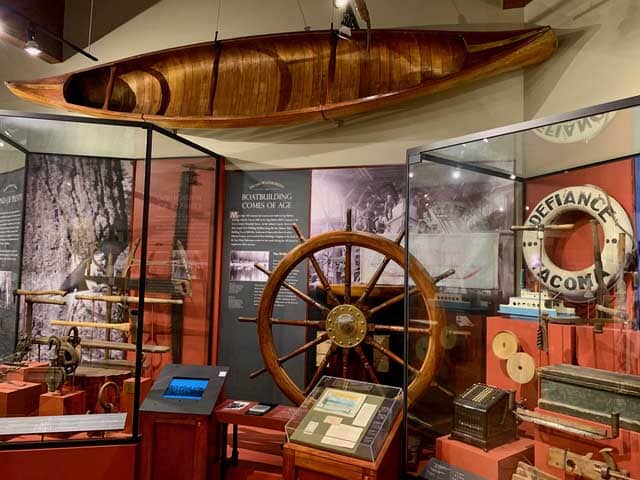
A Willits canoe and associated display at the Harbor History Museum. Photo by Chapin Day
The author, Chapin Day, regrets that he can find no evidence of a family link to Day Island.
Can’t make it to the airport display? You can find Willits canoes hanging around town, including on a wall in the lobby at St. Anthony’s Hospital and overhead in the main gallery of the Gig Harbor History Museum.
